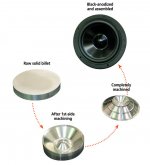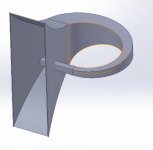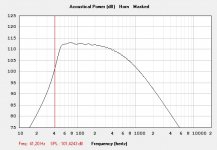So what's most likely to perform best, and most importantly sound best, in average, untreated or moderately treated, leaky (living or demo) rooms?Good writeup.
I also agree that closed boxes will accentuate this effect, while ported ones will eliminate it. A fairly big factor in my book.
At least not this:So what's most likely to perform best, and most importantly sound best, in average, untreated or moderately treated, leaky (living or demo) rooms?
I'd go with multiple closed boxes no matter what the room configuration. Independent LF DSP assumed.
I understand and respect your knowledge/experience in this regard, but you know better than almost anyone what it takes to get it right.
And I'm not so much against closed cabinets, but have too much experience with poor implementations of the concept.
If you cross a largely pistonic, small, but very powerful woofer low (in a tiny sealed cab), the result can be astonishing(ly good). Even free standing in the room.
You need a lot of power - which I don't like, and I prefer a different materialization, but if you get the chance: go and listen to this speaker, or its slightly bigger brother.

Last edited:
2 15"s in a 500l BR with a 500cm2 port tuned to 20hz, in 4 sets, can do 120db/1m down to 20hz within 5.3mmXmax....With the filter knee able to be placed so low, why do you not like ported subs again? Multisub running up until about 100hz? This will allow the front woofers to play midrange with ease. Sounds like a win, except I'd be using dual 18's in the rear on each side.I'd go with multiple closed boxes no matter what the room configuration. Independent LF DSP assumed.
The current mains set up, is pretty good. With another set of subs in the back, 120db/1m is reachable. Because of the spare woofers I chose, I would have to make them BR to reach the levels needed to combine with the fronts and hit 120hz. 4 more 18"s would work sealed but I'd need 14mm xmax at least.
Low tuned vents also contribute above cutoff so I'd imagine this does not help with keeping phase neat and orderly, maybe this the reason why some don't like a vented cab...
... I wonder have those people ever heard a sub tuned to 25hz or lower and came to the conclusion that sealed is still "more desirable"... did these enclosures keep port velocity low enough, etc etc.
Low tuned vents also contribute above cutoff so I'd imagine this does not help with keeping phase neat and orderly, maybe this the reason why some don't like a vented cab...
... I wonder have those people ever heard a sub tuned to 25hz or lower and came to the conclusion that sealed is still "more desirable"... did these enclosures keep port velocity low enough, etc etc.
At a recent hi-fi show with some of the major brands in attendance (some stacked w speakers receiving high accolades in the press and in these pages ) quite a few rooms, if not the majority, went WOOOF WOOOOF. It seems to be a thing & simply draws people.Any enclosure designed to go loud for the sake of it... is either a professional cab or something to show off.
If you read my comments carefully, you should notice that I am very critical and very specific in my reviews.
I certainly don't just listen to the measurement data on a screen.
I listen to individual trees, but never loose sight of the woods.
The perception of music (reproduction) is and remains primarily a personal matter, in which a frame of reference plays a dominant role.
Not the fair lady w a acoustic guitar at midnight BBC-school crowd mind you, but the Queen movie soundtrack at full 💥 masses. I still have that darn We Will We Will ringing in my ears, someone apparently playing the WOOF WOOF at the top of the mix.
I didnt hear any "WOOF WOOOOF" at the Imax... ported subs there right?WOOOF WOOOOF. It seems to be a thing & simply draws people.
Lol, lost the W huh? What sound does the sealed make? "FART FART FART FART"? Or maybe "Whoomp whoomp whoomp"?Imax usually goes more like OOOUUUGHFFF OOOOUUUGHHFFF
Last edited:
Critically damped/transient perfect 0.5 Qtc = critically damped TL, which BTW is the sim I did for you = closest I've found (to date) for replicating this pipe organ's performance playing this CD back before my hearing trailed off.
Good question! When I was doing testing in the late '60s my only means of finding 'critically damped' was the click test using a high quality industrial switch and my wife's much better HF hearing. Fast forward to circa 2k and using MJK's software they simmed slightly different per whatever its damping coefficients, i.e. the TL's stronger modes weren't flat, though not audible to either of us, so moot to my way of thinking, but thanks to all the nifty software/measurement capability available nowadays folks tend to be 'sticklers' for two, three decimal point accuracy........... 
Click Test: https://flic.kr/p/9eWbqJ

Click Test: https://flic.kr/p/9eWbqJ
My reasoning; Larger box and vent equates to higher LF efficiency. Q can be adjusted via a filter. Use big box with big vent, create desired Q with Filter.Critically damped/transient perfect 0.5 Qtc = critically damped TL, which BTW is the sim I did for you = closest I've found (to date) for replicating this pipe organ's performance playing this CD back before my hearing trailed off.
They say that a critically damped TL is the ultimate box in that pressure is the same in each direction of the diaphragms movement, where are as with sealed box there is pressurization and vacuum created, depending on direction of the woofer. They say...Why would a critically damped TL be any different than a closed box at the same Fs and Q?
I think the idea is to allow a little more resonance to increase efficiency over sealed while taking advantage of the lower resolution of the ear in LF, allowing more excess GD in a supposedly dominate room, allowing more excess decay.....still a ways away from an undamped vent, with much higher excess GD/Decay with the same cutoff. Tuning low is the real goal if aiming for accuracy, in my opinion, No less than a horn tweeter, the desired passband should start double of Cutoff.The last time I made a critically damped TL (around the time the Augspurger alignment tables were introduced), I found it was sufficiently similar to a closed box that I didn't do it any more.
Last edited:
Yeah, why my drivers are very efficient in big cabs, though while the terminus is 0.5 Sd, the vent on a removable baffle is smaller since cabs were originally tuned to 32 Hz, then as ever lower recordings became available the current tuning that shook my house is ~14 Hz, but have kept it ~plugged since then, so leaky sealed now, which with good corner loading is plenty good enough for any music, movies I've watched since then.
- Home
- Loudspeakers
- Multi-Way
- Is it possible to cover the whole spectrum, high SPL, low distortion with a 2-way?

